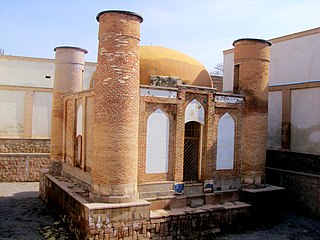Related Research Articles

Maragheh is a city in the Central District of Maragheh County, East Azerbaijan province, Iran, serving as capital of both the county and the district. Maragheh is on the bank of the river Sufi Chay. It is 130 kilometres (81 mi) from Tabriz, the largest city in northwestern Iran.

Nuh II was amir of the Samanids (976–997). He was the son and successor of Mansur I.

Abu Salih Mansur, better known as Mansur I (منصور) was amir of the Samanids from 961 to 976. The son of Nuh I, his reign was characterized by weak rule and perpetual financial troubles. Mansur was notably the first Samanid ruler to the use title of King of Kings (Shahanshah), most likely as a response to his rival, the Buyid ruler Adud al-Dawla, who likewise used the title. He is also known by the sobriquet Amīr-i Sadid.

The Shaddadids were a Sunni Muslim dynasty of Kurdish origin. who ruled in various parts of Armenia and Arran from 951 to 1199 AD. They were established in Dvin. Through their long tenure in Armenia, they often intermarried with the Bagratuni royal family of Armenia.

Qatran Tabrizi was a Persian writer, who is considered to have been one of the leading poets in 11th-century Iran. A native of the northwestern region of Azarbaijan, he spent all of his life there as well as in the neighbouring region of Transcaucasia, mainly serving as a court poet under the local dynasties of the Rawadids and Shaddadids.

Rawwadid, Ravvadid, or Banū Rawwād (955–1071) was a Sunni Muslim Kurdish dynasty, centered in the northwestern region of Adharbayjan (Azerbaijan) between the late 8th and early 13th centuries.

Abu Ahmad Wali 'l-Dawla Khalaf ibn Ahmad was the Saffarid amir of Sistan from 963 until 1002. Although he was renowned in the eastern Islamic world as a scholar, his reign was characterized by violence and instability, and Saffarid rule over Sistan came to an end with his deposition.
The Al-i Muhtaj or Muhtajids was an Iranian or Iranicized Arab ruling family of the small principality of Chaghaniyan. They ruled during the 10th and early 11th centuries.
The Farighunids were an Iranian dynasty that ruled Guzgan in the late 9th, 10th and early 11th centuries. They were ultimately deposed by the ruler of the Ghaznavid Empire, Sultan Mahmud.

The Sallarid dynasty, was a Muslim dynasty of Daylami origin, which ruled in Tarom, Samiran, Daylam, Gilan and subsequently Azerbaijan, Arran, and some districts in Eastern Armenia in the 2nd half of the 10th century. They constitute part of the period in history that has been named the Iranian Intermezzo, a period that saw the rise of native Iranian dynasties during the 9th to the 11th centuries.

Hadhabani or Hadhbāni, Hadhbānī, Hadhbâniyya was a large medieval and most powerful Sunni Muslim Kurdish tribe. it made various Emirates and dynasties from the Caucasus, all the way to upper Mesopotamia.
Anushirvan ibn Lashkari was the son and successor of Lashkari ibn Musa and briefly the seventh emir of the Shaddadids at Ganja in 1049.

Abu'l-Aswar or Abu'l-Asvar Shavur ibn Fadl ibn Muhammad ibn Shaddad was a member of the Shaddadid dynasty. Between 1049 and 1067 he was the eighth Shaddadid ruler of Arran from Ganja. Prior to that, he ruled the city of Dvin from 1022 as an autonomous lord. A capable warrior, and a wise and cunning ruler, Abu'l-Aswar was engaged in several conflicts with most of his neighbours.

Yazid ibn Ahmad or Yazid II was the tenth Shirvanshah.

Wahsudan ibn Muhammad was the Sallarid ruler of Daylam (941/2–967). He was the son of Muhammad bin Musafir, the ruler of Tarum.
Manṣūr ibn Luʾluʾ, also known by his laqab of Murtaḍā ad-Dawla, was the ruler of the Emirate of Aleppo between 1008 and 1016. He succeeded his father Lu'lu' al-Kabir, with whom he had shared power. Unlike Lu'lu', however, Mansur's rule was opposed by Aleppo's notables, who chafed at his oppression and monopolization of power. Both Mansur and his father harassed the remaining members of the Hamdanid dynasty, in whose name they ostensibly ruled. On the diplomatic front, Mansur balanced ties with both the Byzantine Empire and the Fatimid Caliphate, and maintained the emirate's Shia Muslim orientation.

Abu Nasr Mamlan II was the last Rawadid amir (ruler) of Azarbaijan from 1058/9 to 1071. He was the son and successor of Abu Mansur Wahsudan. He was along with his sons arrested in 1070 by his suzerain, the Seljuk ruler Alp Arslan, thus marking the end of the Rawadid dynasty. However, their descendants, the Ahmadilis, recaptured Maragha in the early 12th-century.

Abu Mansur Wahsudan was the penultimate Rawadid amir (ruler) of Azarbaijan from 1025 to 1058/59. He is considered the most prominent ruler of his dynasty. With the assistance of his Kurdish neighbours, he initially contained the attacks of migrating Turkmen tribes, but was eventually forced to acknowledge the authority of the Seljuk ruler Tughril in 1054. He was succeeded by his son Abu Nasr Mamlan II.
Muhammad ibn Husayn al-Rawadi was the founder of the Rawadid dynasty, ruling parts of Armenia and Azarbaijan in the mid 10th-century. He was succeeded by his son Abu'l-Hayja Husayn I between 953–956.

The Imamzadeh Chaharmanar also known locally as Imamzadeh Ali ibn Mujaheed is a historic mausoleum located in Tabriz, Iran. It was built during the Seljuk period and is number 651 on Iran's list of national monuments.